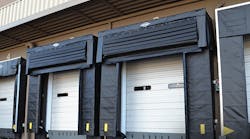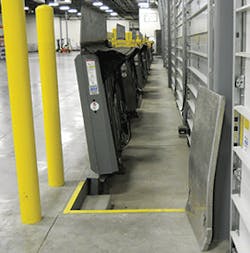Warehouse facility managers have always faced safety challenges, particularly with regard to loading dock areas. While significant advances in dock safety equipment and procedures have taken place in recent years, loading docks remain an area of concern—and managers now face a host of new issues to deal with.
The re-opening of Panama Canal is among the largest. With post-Panamax ships now able to reach the eastern United States, an influx of intermodal containers will arrive at Gulf Coast and Atlantic Coast ports. This means we'll see more intermodal cargo container chassis on highways and at loading docks across the country.
Although on a macro level this is a great enhancement to the global logistics infrastructure, on a micro level it could be a concern for warehouses and distribution centers (DCs). That's because many intermodal containers have obstructed rear impact guards (RIGs), making them resistant to most vehicle restraints. This is a two-sided problem as unsecured trailers not only create a safety issue, they are also more conducive to cargo theft.
According to the FBI, cargo theft is a $30 billion problem in the U.S. and it is on the rise. Trucking industry research organization Freightwatch reports that cargo theft was up 8% in the first quarter of 2016 compared to Q1 of 2015, and was up 13% in the quarter before that. Even more alarming is where these incidents are taking place. While parking lots, truck stops and unsecured lots are frequent locations, seemingly secure DCs can fall victim to this growing crime. In fact, nearly a quarter of all cargo thefts occur at DCs and warehouse yards, according to CargoNet. Shockingly, they are the most frequent area for cargo theft to occur.
From Safety to Security
Fortunately, some of the same equipment and procedural advances that have made loading docks safer for workers also help protect them from cargo thieves. The first step in any dock safety and security protocol is to lock the trailer to the dock. This is typically done using a restraint on either the trailer's tire or RIG. The most common type of restraint is the rotating hook design, which automatically wraps around the RIG as the trailer backs up to the dock wall.
By locking onto the RIG, these restraints prevent a range of accidents, including trailer tip-over (from landing gear collapse); early departure (in which the semi-trailer gets pulled away with a forklift still inside of it); or trailer creep (in which the vibration of forklift traffic causes the trailer to progressively move away from the dock wall).
While standard rotating hooks work well for traditional over-the-road semi-trailers, they are not always compatible with intermodal container chassis. Specifically, if the container chassis' RIG is obstructed, the hook may not become fully engaged and may allow the trailer to creep away from the wall during loading and unloading or release completely in the case of an aggressive early departure by the semi driver. Either situation creates a potential for catastrophic injury, as well as opening for thieves or contaminants to access the cargo inside the trailer.
The newest generation of vehicle restraints has been designed to work with all types of trailers, including obstructed-RIG intermodal chassis. They use a "shadow hook" design, which means that if the hook comes in contact with a rear-impact guard obstruction during engagement, a secondary "shadow" hook pivots to secure the trailer in place. If the trailer moves, the shadow hook locks in a safety stop position, keeping the trailer secured against the building.
The new restraints also are designed to re-fire into a locking position if a trailer attempts to pull away or the restraint is tampered with externally. Thus, even if a thief is able to pry the hook or barrier down, the lock will re-engage, potentially thwarting an attempt to steal the trailer or its cargo. Additionally, the new generation of vehicle restraints can be integrated into building management or security systems, so if a restraint is tampered with, the building security system will be activated. This provides yet another measure of security and protection against external tampering.
Mind the Gap
Once a trailer is secured at the loading dock, the next step is linking the gap between the loading dock floor and the trailer bed. The key for facilities managers is to find a dock leveler that provides the smoothest possible transition between the facility floor and the trailer. This helps reduce "dock shock" or whole-body vibration to forklift operators going in and out of the trailer, as well as damage to the product and equipment. It also reduces trailer creep, thus making it harder for thieves or contaminants to access the trailer.
The most advanced levelers incorporate a constant-radius rear hinge that reduces the bumps and gaps at the rear of the leveler, as well as two-point crown control and an optimized lip chamfer at the front of the leveler. This reduces the speed bump effect normally felt by forklift drivers as they enter and exit the trailer.
When it comes to maintaining security, vertical-storing dock levelers are generally considered the gold standard. Unlike a pit-style leveler, a (stored) vertical leveler allows the loading dock door to close directly on the pit floor—rather than the leveler itself—protecting the dock door from damage and minimizing points of entry for dust, debris, rodents, outside air infiltration and other contaminants. Additionally, the vertical design makes it easy to clean or wash down the pit floor when the leveler is in the upright stored position.
Although a number of companies offer vertical dock levelers, facility managers should consider a variety of specific features before committing to an installation. Most importantly, look for a "drive-thru" application that allows trailer doors to be opened inside the facility. Opening and closing trailer doors inside the loading dock, rather than on the drive approach, allow loading dock staff to place or remove the trailer's seal from inside the building—maintaining supply chain integrity.
Creating a Safe Sequence of Operation
Traditionally, the various pieces of loading dock equipment—including vehicle restraints, levelers and overhead doors—are operated independently of each other.
Today's leading loading dock control systems provide facilities managers the ability to program a safe sequence of operation.
For example, the most advanced dock control systems can be programmed with a green light interlock, which disables the use of the hydraulic leveler or overhead door until the vehicle restraint is safely engaged; an overhead door interlock, which requires overhead doors to be opened prior to leveler operation; or a stored leveler interlock, which ensures that the leveler is stored safely before the restraint can release the trailer. If an inexperienced worker presses the control box button for an individual system element in the wrong sequence, it won't work. This control box helps ensure that no safety procedures will be skipped.
Protecting Vacant Docks
By foot or forklift, a worker falling from a dock door opening can be extremely dangerous. Because of this, many facilities use safety lip barriers on dock levelers or barriers positioned near the edge of the dock door to prevent falls. Some can even be integrated into the safe sequence of operation, mentioned above.
Once the trailer is securely in place, the lock button is pressed, the light on the control box turns green and the barrier releases for easy access to the trailer.
In many instances, these barriers are made from reinforced fabric that offers resistance. The most advanced barriers—made from PVC-coated fiberglass mesh and heavy-duty polyester—can stretch across openings 16' 5" wide and are able to stop up to 30,000 lbs. with minimal damage to the barrier.
Ensure Worker Safety and Cargo Security
Implementing advanced equipment and a safe sequence of operations at the loading dock is an investment. However, stolen cargo represents thousands of dollars in lost profits and incalculable damage to your company's reputation. Injured employees are equally damaging to the bottom line and company morale.
Additionally, the fallout from these issues can become a drain on future revenues.
Taking the proper steps to ensure that employees are safe and cargo is secure is a wise investment from almost any perspective. In the long run, it might be one of the best business decisions a facility manager can make.
Walt Swietlik is director of customer relations and sales support for Rite-Hite, a manufacturer of loading dock equipment, industrial doors, safety barriers and HVLS industrial fans. Photos provided by Rite-Hite.





